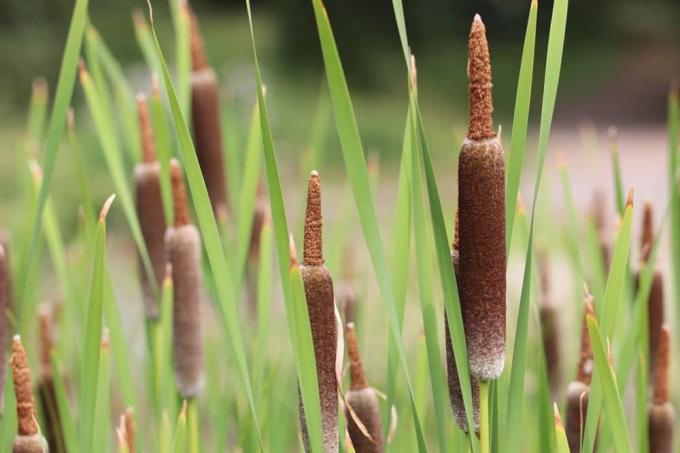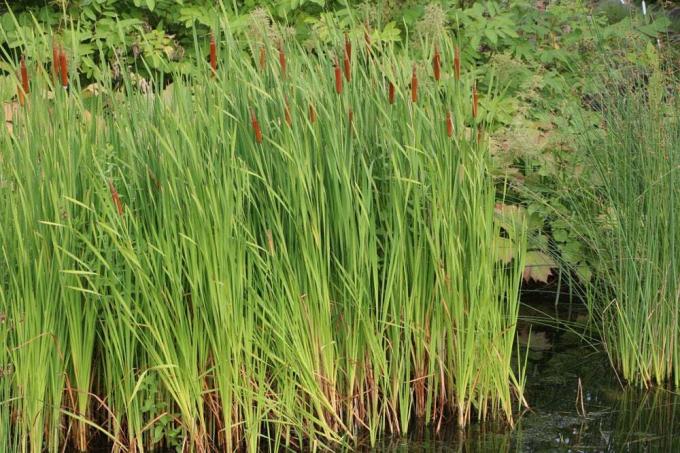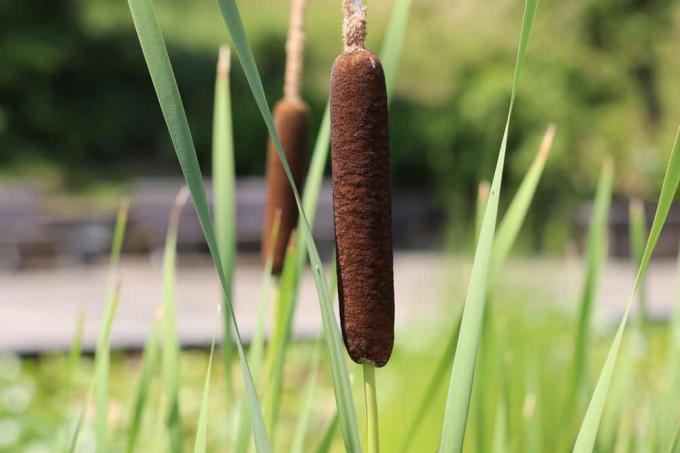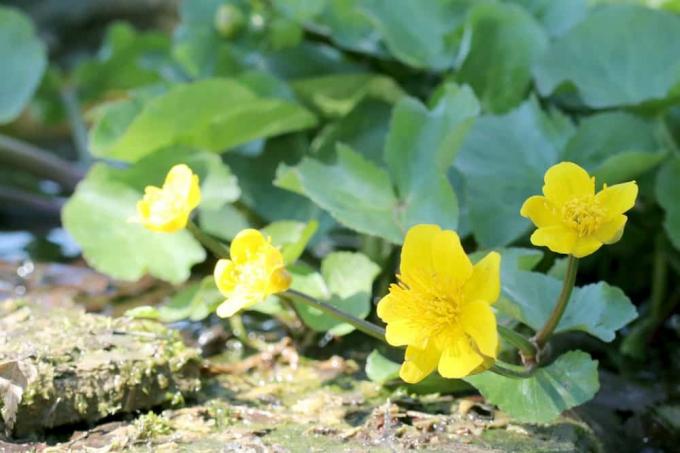

Table of contents
- Popular types
- use
- location and soil
- multiply
- collect seeds yourself
- Sow seeds directly
- Recreate natural conditions
- Exploit vegetative propagation strategy
- Plant
- bucket
- Cut
- Regularly remove withered leaves
- Cut cobs in summer
- Take a break from editing in the fall
- Carry out radical pruning in spring
- hibernate
- diseases and pests
Cattails are a genus within the grass family that includes 16 to 40 species. They are distributed worldwide and occur in both temperate latitudes and tropical regions. Cattails are valued as ornamental grasses because of their striking leaf mass and decorative inflorescences. They characterize moist habitats near water bodies and form dense stands.
Popular types
Cattails are valued by many pond owners because of their water-purifying effect. The plants make a valuable contribution to nature conservation in your own garden, as they offer smaller birds a protected habitat. Within the genus Typha there are some species that are often planted as ornamental grass.
- Laxmann's cattail (Typha laxmannii): up to 120 centimeters high
- Broad-leaved cattail (Typha latifolia): reaches stature heights of up to 200 centimeters
- Dwarf Cattail (Typha minima): stays 40 centimeters low
- Narrow-leaved cattail (Typha angustifolia): up to 200 centimeters high
Tip:
The dwarf cattail is less of a problem when it comes to overgrowth. However, he places higher demands on the location.
use
The higher-growing species are suitable for deeper water zones, while the dwarf cattail should not be planted deeper than 20 centimeters. Since all Typha species tend to proliferate, they should only be planted in sufficiently large bodies of water with a minimum area of seven to ten square meters. The better solution is a separate ditch in which cattails are planted exclusively. This also gives you excellent privacy protection. Other competitive reed plants or flowering plants with similar requirements can be planted between the cattails for more variety.
- Common reed (Phragmites australis)
- Tall Cyprus Grass (Cyperus longus)
- Yellow flag (Iris pseudacorus)
- Loosestrife (Lytrum salicaria)
- Water mint (Mentha aquatica)
location and soil
Cattails have adapted to moist to wet locations. They grow in intermittently flooded areas that are often affected by brackish water. Their natural habitats are on different bodies of water.
- moist edges of standing water
- muddy river banks
- swamps and bogs

Nutritious soil that does not dry out is important. Plant the cattail in a boggy, loamy soil with a small amount of sand. The sweet grasses prefer full sun. They can be placed in a plant basket directly in low garden ponds or in the shallow water zone at the edge of the pond. The ideal water depth for cattails is between 30 and 50 centimetres. Occasionally the rhizomes grow to a depth of 100 centimeters. The pH of the water should be in the medium-hard range between 8.4 and 14.
multiply
Cattails can be propagated via seeds or by dividing the tuberous roots. Seed propagation requires some patience and is more complex than dividing the rhizome.
collect seeds yourself
Cattail loses its ability to germinate very quickly. Seeds must be sown within a few weeks of fruit ripening. Only absolutely fresh seeds germinate reliably, which is why specialist shops rarely offer seeds. Observe the brown cobs regularly to wait for the right time. The fruit ripens between October and November. Once the cobs burst open revealing the cream-colored cotton balls, it's time to harvest the seeds.
Sow seeds directly
Immediately after the collection, the seed is sown. Use a substrate that has properties similar to a pond bottom. It should be nutritious and as muddy as possible. With cattails, you don't have to worry about soil permeability. The marsh plants show no problems with waterlogging and thrive in compacted soil with a high proportion of clay.
- Sow in late fall or winter
- Germination occurs next spring
Recreate natural conditions
The grass, affectionately known as lamp cleaner, is also suitable for the bucket. To do this, you can grow the seeds indoors. Fill a shallow container with muddy soil and plant the seeds about an inch or two deep in the substrate. The bowl is filled with lime-free water so that the substrate is wet.
- Store at 20 degrees Celsius for one to two weeks
- then refrigerate for four to six weeks
- a warm window seat is needed for germination
This sequence mimics the natural weather conditions that occur in the great outdoors. After exposure to warm conditions on the partially shaded windowsill, mature seeds require a cold stimulus. The seed is encouraged to germinate under frost-free conditions on the balcony or in the refrigerator. This is then done at mild temperatures on the windowsill.
Exploit vegetative propagation strategy
Cattails develop a vigorous rhizome that crawls through the substrate by means of shoot sections shallow below the soil surface. In this way, a marsh plant can develop an entire stand of plants. These are identical clones. In order to increase specific breeding forms, the rhizomes are divided and planted elsewhere. The ideal time for this measure is in the spring, before the plants sprout again. Dig the rhizomes out of the substrate and separate the overgrown sections from the old rhizome. Cattails prove to be robust and resilient. You don't have to treat the interface additionally, because it will grow over by itself within a short time.
Plant
Cattails are often sold in the planter basket, which is recommended for direct planting. The long rhizome runners can easily grow through the mesh of conventional mesh baskets, so you should replace the basket with a sturdy and impenetrable container. The strong roots can also pierce pond liner. Up to three plants can be accommodated in one container. Eight to twelve plants of the larger specimens per square meter are sufficient to maintain a dense population. The plants grow together over time. If the privacy screen is required faster, up to 16 copies can be placed next to each other. For Typha angustifolia and Typha minima, two to four plants per square meter are sufficient.
Tip:
Place the cattail in a sturdy mortar tub filled with nutrient soil that will be lowered into the garden pond. With two to three tubs right next to each other, you can create a mini reed bed.
bucket

You can use the rawtail to decorate a mini pond for the balcony or terrace if you don't have space for a pond in the garden. Get a frost-proof flower pot without a hole. A container made of plastic is ideal, because clay or stone can easily be cracked by frost if you spend the winter outdoors. Fill the bottom with a muddy substrate and plant the cattail in the soil. Alternatively, you can use the grasses together with their plant baskets and weigh them down with stones.
Tip:
The mini pond gets some color when you plant water lilies. Plant the aquatic plants in April to enjoy the first blooms in summer.
Cut
You should always keep an eye on the cattail, because unobserved it quickly takes up large areas. Targeted pruning measures at the right time of year therefore receive special attention.
Regularly remove withered leaves
It is important for the appearance that old parts of the plant are removed immediately. As soon as a stalk has dried up, the cattail drives out of the rhizome in another place. Dead shoots do not develop new shoots and can be cut off without hesitation. In smaller bodies of water, the leaf mass should also be continuously trimmed so that the cattail does not dominate the overall picture and rob weaker species of the light.
Cut cobs in summer
The bulbs of the lamp cleaners prove to be decorative elements in dried bouquets and flower arrangements. For this you need to cut off the inflorescence early. When the fruit is already ripe, the cobs can burst open at any time, releasing the hairy seeds. The cobs can already be cut off at the beginning of the flowering period and then dried. This measure prevents uncontrolled propagation by seeds that are spread over long distances with the wind.
Tip:
Place the cobs in a warm and airy place to dry for two weeks. This keeps the stems stable for a long time.
Take a break from editing in the fall

Autumn becomes a time of little work for gardeners with cattail beds, because the thick stalks of the sweet grasses remain in place over the winter. The dried stems with the stiffly upright leaves brighten up the gray garden during the cold and dreary season. You are also doing something to protect nature, because the hollow stems offer a protected retreat for wintering insects. The dried cobs are a popular food source for small songbirds, which feed on the leftover seeds during the winter.
Carry out radical pruning in spring
Cattails are only cut back in the spring to make room for fresh shoots. Grab several stems by their base and cut the bunch just above the ground. With this measure, you should also radically curb rampant stocks and shorten rhizomes, because otherwise the stock expands uncontrollably and crowds out other plants in the Neighborhood.
hibernate
Cattails are hardy and survive the cold season without any problems, provided the substrate with the rhizomes does not freeze. If a layer of ice forms only on the surface of the water, there is no danger to the tubers. If severe winter months are imminent, you should take the planters out of the shallow water zones as a precaution and overwinter them in the basement, frost-free. Otherwise, it is sufficient to tie the stalks together in the fall. This will prevent dead leaves from detaching and sinking to the bottom of the water.
diseases and pests
Species of the genus Typha prove to be robust. They are rarely attacked by fungi, aphids or pathogens. Snails aren't a problem either. The only danger comes from a species of moth. The marsh owls (Nongaria) have largely specialized in the plants. The great cattail owl, which lays its eggs on the leaves of the marsh plants, is widespread. Once the larvae hatch, they feed on the leaf mass until pupation. However, the moths do not occur in large numbers, so cattails regenerate themselves in nature. You don't have to worry about an infestation in the garden.
 garden editorial
garden editorial I write about everything that interests me in my garden.
Learn more about pond plants

Waterweed, Elodea densa - care from A to Z
Waterweed is one of the fast-growing aquatic plants that can adapt extremely well to a wide variety of water conditions. Not only does it do well in the garden pond, the Elodea densa can also be used in freshwater aquariums.

Marsh iris, Iris pseudacorus: care from A to Z
A pond is a special attraction in the garden and with the right planting it becomes an eye-catcher. A frequently used aquatic plant is the somewhat exotic-looking marsh or water iris. It is the perfect pond plant, which also has special properties.

Hechtkraut, Pontederia: care from A - Z | 5 tips for wintering
Hechtkraut belongs to the water hyacinths and originally comes from America. However, it has also been cultivated since the 16th century, as it fulfills important functions on the shores of lakes and ponds. Interested hobby gardeners can find out here how care and overwintering should look like.

Marsh marigold in the pond: location, care and propagation
The marsh marigold (Caltha palustris) is a real early bloomer and the first flowering plant in the garden pond. In spring it shows its bright yellow flowers, which illuminate the edges of ponds and water bodies as well as wet meadows. It is a good plant partner and very easy to care for.

Cut reeds, but when? Instructions + info at the best time
Green reeds are often planted because they grow incredibly fast. It will fill any suitable spot in just one gardening season. Sometimes, however, more stalks sprout than the gardener would like. When can he give the reed a short cut?

Gauklerblume - cultivation and care - is it hardy?
Juggler flowers form funny blossoms reminiscent of small faces. Native to the yellow-red range, they now also bloom in pink or blue. Some species love the moist environment and prefer to show off their color at the edge of the pond. A little care is enough for them.
